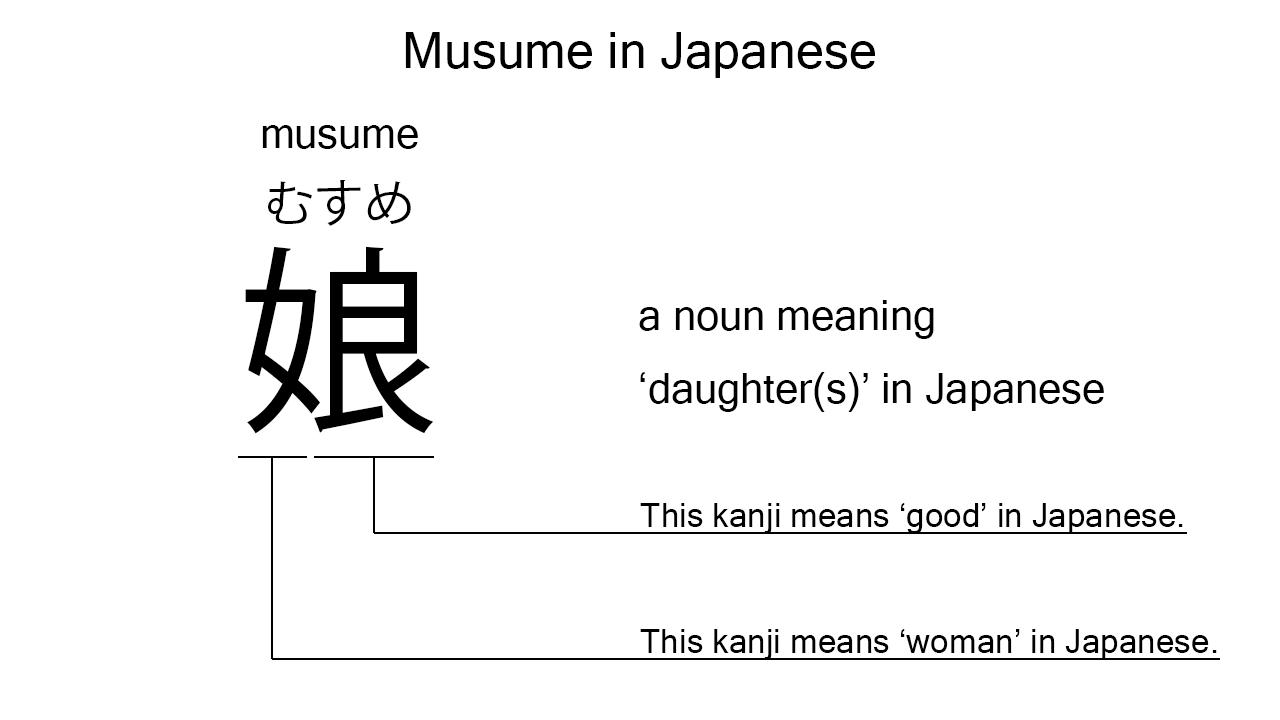What does “musume” mean in Japanese?
Native speakers use musume often to mean a ‘daughter’ in Japanese. Perhaps, some Japanese learners know this word as it is sometimes used in Japanese movies, songs, novels, manga, anime, and the like. In this blog post, however, I’m explaining this word in detail based on its kanji character. And also, I’m explaining how to use it through example sentences. My explanations would help Japanese learners understand musume more clearly. Then, let’s get started!
Contents
Definition and meanings of “musume”
Let me start with the definition and meanings of musume.
- musume – 娘 (むすめ) : a noun meaning a ‘daughter’ in Japanese. This can also work as plural. Learn more about Japanese plural. It’s also worth mentioning here that native speakers occasionally use this noun to refer to a young woman or women in Japanese.
The definition and meanings are not that difficult, I think. To understand this noun more clearly, however, let me explain its kanji character in detail.
Musume in kanji
The kanji character of musume consists of the following two parts:
- 女 : a kanji radical for women.
- 良 : a kanji character used to mean ‘well‘, ‘good’, or such in Japanese.
From these two kanji parts, we can understand that musume literally means a good woman or girl in Japanese. This literal interpretation is not completely in line with the actual meanings, but still understandable, I think. Many fathers think that their daughters are good girls.

When we meet new kanji characters, we should check their parts in detail to understand their meanings clearly and deeply. In many cases, kanji parts tell us a lot about the meanings of the characters they form. Actually, here, we could get better understanding of musume through the detailed check above.
So far, I’ve explained the definition and meanings of musume together with its kanji parts. Then, let me explain how to use it through the example sentences below.
How to say “daughter” in Japanese
kanojo wa watashi no musume desu – 彼女は私の娘です (かのじょはわたしのむすめです)
She is my daughter.
Below are the new words used in the example sentence.
- kanojo – 彼女 (かのじょ) : a pronoun meaning ‘she’ in Japanese.
- wa – は : a binding particle working as a case marker or topic marker. In the example, this works after kanojo to make the subject in the sentence.
- watashi – 私 (わたし) : a pronoun meaning ‘I’ in Japanese.
- no – の : a case particle used after a noun or pronoun to make its possessive case. In the example, this is used after watashi to make its possessive case, watashi no, which means ‘my’ in Japanese.
- desu – です : an auxiliary verb used after a noun or adjective to make it polite. Probably, this is well known as a part of Japanese desu form. In the example, this is used after watashi no musume to make it sound polite.
This is a typical usage of musume. In this example, it works together with the possessive case, watashi no, to mean ‘my daughter’ in Japanese. When we want to mean a ‘daughter’ or ‘daughters’ in Japanese, anyway, this noun is the best option.
Another example of “musume”
kanojo wa rippana musume ni nat ta – 彼女は立派な娘になった (かのじょはりっぱなむすめになった)
She became an outstanding woman.
Below are the new words used in the example sentence.
- rippana – 立派な (りっぱな) : a na-adjective meaning ‘outstanding’, ‘excellent’, ‘brilliant’, or such in Japanese. In the example, this works in front of musume to describe it.
- ni – に : a case particle used to say what someone or something becomes after a change or action. In the example, this is used after rippana musume to say what she became after the change.
- nat – なっ : one conjugation of the verb, naru, which means ‘to become’, ‘to get’, ‘to turn’, or such in Japanese. In the example, it has been conjugated for the better connection with its following word.
- ta – た : an auxiliary verb used after a verb, adjective, or auxiliary verb to make its past tense form. Probably, this is well known as a part of Japanese ta form. In the example, this is used after nat to make its past tense form, nat ta.
This is another example of musume. In this example, it works to mean a ‘(young) woman’ in Japanese. Again, but native speakers occasionally use this noun to refer to a young woman or women in Japanese.
Summary
In this blog post, I’ve explained the definition and meanings of musume in detail based on its kanji character. And also, I’ve explained how to use it through the example sentences. Let me summarize them as follows.
- musume – 娘 (むすめ) : a noun meaning a ‘daughter’ in Japanese. This can also work as plural. It’s also worth mentioning here that native speakers occasionally use this noun to refer to a young woman or women in Japanese. The left part of this kanji character means a ‘woman’ or ‘girl’; the right one means ‘good’. So, this kanji character literally means a good woman or girl in Japanese. This literal interpretation is not completely in line with the actual meanings, but still understandable, I think. Many fathers think that their daughters are good girls.
Hope my explanations are understandable and helpful for Japanese learners.
Leave a Reply